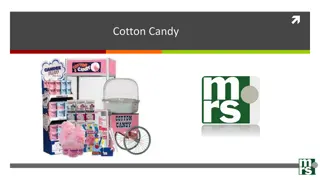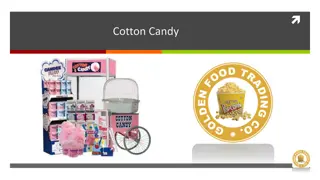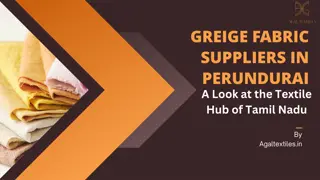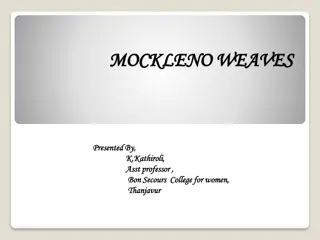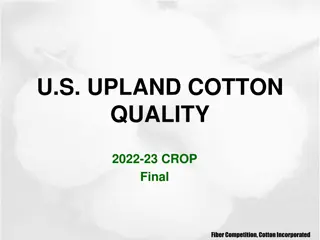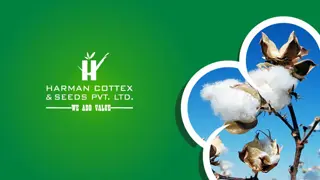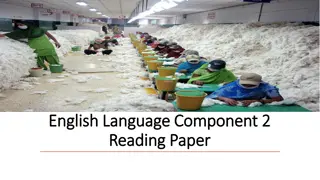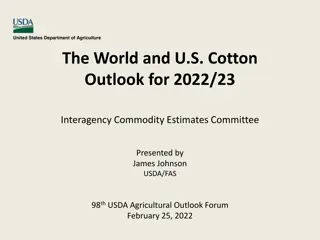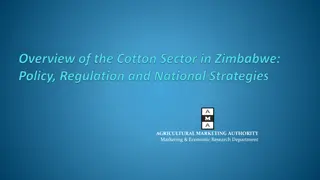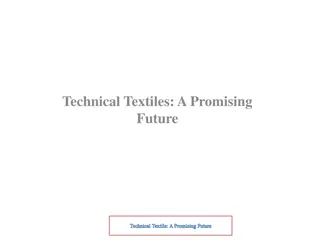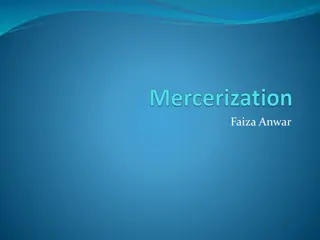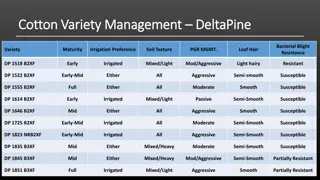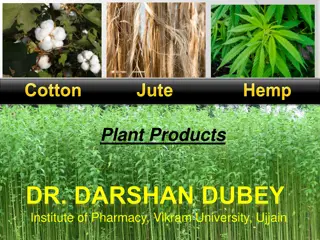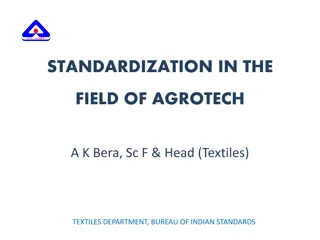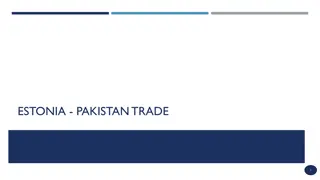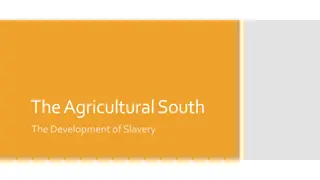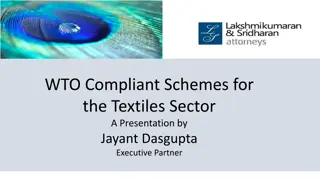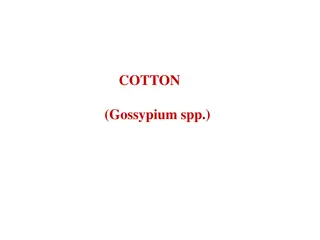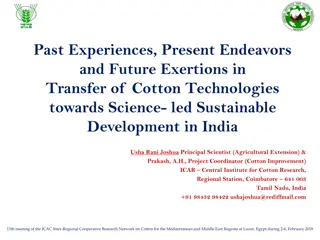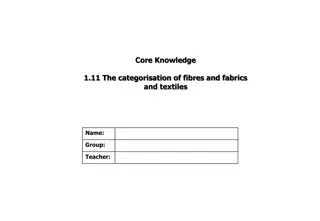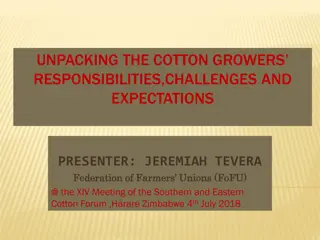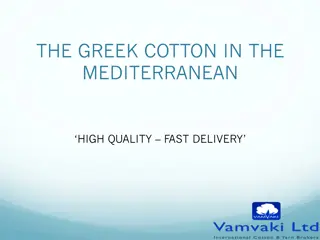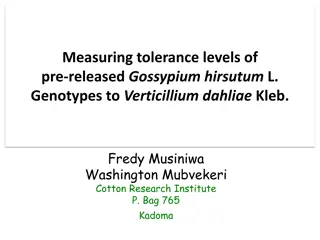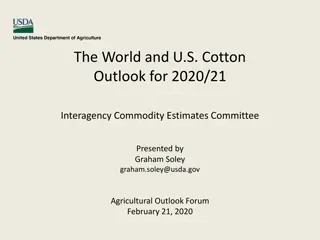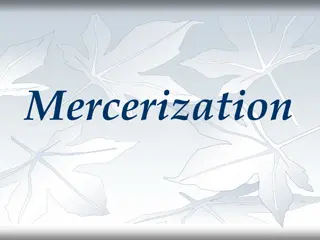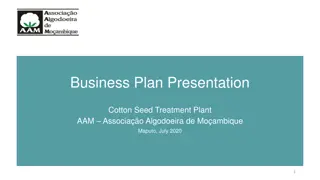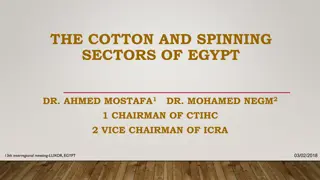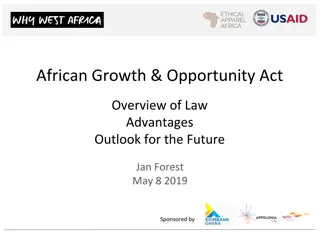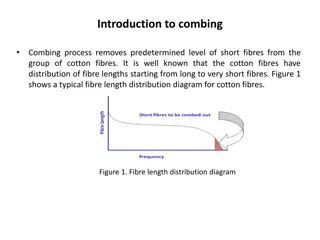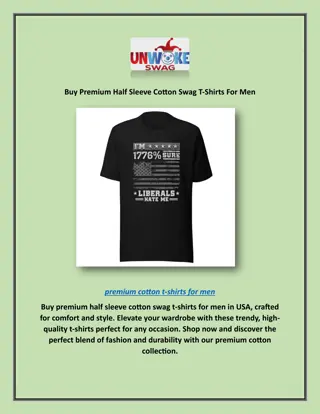Cotton Candy Equipment and Supplies for Fun Food Concessions in the Middle East
M.R.S. Packaging Ltd is a leading provider of high-quality concessions equipment and supplies in the Middle Eastern and GCC region. They offer a wide range of products including cotton candy machines, flossine flavors, and attractive display stands. Cotton candy is a popular choice for concessions d
0 views • 12 slides
Golden Food Trading: Your One-Stop Supplier for Fun Food Concession Equipment
Golden Food Trading is a leading provider of high-quality concessions equipment and supplies in the Middle Eastern GCC Region. Specializing in cotton candy machines, they offer a range of flavors, equipment, and accessories to help you set up a successful cotton candy concession. From affordable cot
0 views • 12 slides
Adore Custom with Cotton Planet Ireland's Go-To Source for Christening and Cotton Blankets Online
Tradition is valuable, but so is adaptability. For this reason, Cotton Planet also offers a wide range of high-quality Cotton Blankets online in Ireland. They have everything you need, from a lightweight blanket to keep your child warm during naps to a bigger comforter for frigid winter evenings.
1 views • 3 slides
Top Greige Fabric Suppliers in Perundurai: Quality and Affordable Options – agal
Are you in search of high-quality greige fabric at competitive prices? Look no further than Agal Textiles, your premier greige fabric supplier in Perundurai. We specialize in providing a wide range of greige fabrics that cater to diverse industry needs. Our commitment to quality ensures that you rec
0 views • 7 slides
A Level Textiles FAQs Answered: Studio Access, Course Requirements, University Pathways
Gain insights into utilizing textiles studio facilities, pursuing A Level Textiles without GCSE background, recommended A Level subject pairings, and universities A Level Textiles students have progressed to. Understand the opportunities, requirements, and pathways in the field of textiles education
0 views • 8 slides
Understanding Mock Leno Weaves in Textiles
Mock leno weaves, also known as imitation leno, are ordinary weaves that mimic the appearance of gauze or leno styles. This derivative weave involves interlacing two or three warp yarns, creating a unique aesthetic similar to gauze fabrics. Mock leno finds application in various textiles like canvas
0 views • 10 slides
Upland Cotton Quality Trends and Analysis 2022-23
Explore the latest trends in U.S. upland cotton quality for the 2022-23 crop, including fiber competition data, yield trends, micronaire distribution, average micronaire values, regional comparisons, strength trends, and distribution. Gain insights into micronaire levels, yield trends, and strength
0 views • 30 slides
Understanding Easy-Care and Durable Press Finishes for Textiles
Easy-care and durable press finishes play a vital role in enhancing the quality and longevity of textiles, particularly those made of cellulose fibers. These finishes reduce shrinkage, improve wrinkle recovery, and maintain fabric appearance. While beneficial, they may impact fiber flexibility and s
0 views • 25 slides
Exploring Fibre Yielding Plants: A Focus on Cotton (Gossypium) and Its Economic Botany
Uncover the world of fibre-yielding plants, with a special emphasis on cotton (Gossypium) from the Malvaceae family. Learn about the economic significance of cotton bolls and the classification of cotton fibres into different categories. Delve into the details of Gossypium hirsutum and the various c
1 views • 17 slides
Harman Cottex - Adding Value to Cotton Industry
Harman Cottex, founded in 1998, aims to add value to the cotton industry by producing superior quality cotton products and expanding its presence globally. With a focus on innovation, customer satisfaction, and compliance with global standards, Harman Cottex is a trusted name in trading and manufact
0 views • 11 slides
Emerging Trends in Indian Textile Industry Post-COVID Era
India has experienced significant growth in textile production, particularly in PPE kits, masks, and technical textiles, shifting from a net importer to a major global supplier. The country is focused on diversifying products, increasing exports, and enhancing capabilities across the textile value c
0 views • 6 slides
Art, Textiles & Photography A Level Course Overview
Explore a range of specialist skills and techniques in fine art, photography, digital, and textiles. Develop personal work in response to themes, incorporating research, analysis, and presentation skills. Understand assessment components and requirements, including coursework and externally set assi
0 views • 6 slides
Insights on Cotton Mills and Workers' Conditions in English Language Component 2 Reading Paper
The reading section of English Language Component 2 paper delves into the conditions of workers, particularly young girls, in cotton mills. Robin Pagna's article sheds light on the harsh reality faced by these workers, while Friedrich Engels' text provides further insight into the detrimental effect
1 views • 22 slides
Global Textile Chemicals for Technical Textiles Market
Global Textile Chemicals for Technical Textiles Market
0 views • 7 slides
Advancements in Geosynthetics & Technical Textiles Applications on Indian Railways
Indian Railways, with its vast network, has significant requirements for geosynthetics and technical textiles in construction, maintenance, and safety. The adoption of new technologies, including technical textiles, is crucial for improving efficiency, safety, and overall operations. Functional requ
0 views • 25 slides
Global Cotton Outlook 2022/23: Consumption Recovery, Production Growth, and Price Trends
The USDA's Interagency Commodity Estimates Committee presented the global cotton outlook for 2022/23, highlighting a continued consumption recovery, a rise in production to the highest level in 11 years, and a dip in global stocks leading to price retreats. The report discusses the factors influenci
0 views • 36 slides
Unlocking Creative Potential in 3D Design, Graphics, and Textiles for Primary School Students
Explore a comprehensive curriculum map for Year 7 and 8 students, guiding them through engaging rotations in 3D design, graphics, and textiles. From creating memo holders inspired by artists to designing logos for funky fruit juice bars, students develop key skills in woodworking, metalworking, typo
0 views • 6 slides
Overview of Cotton Production and Value Chain in Zimbabwe
Cotton production in Zimbabwe plays a crucial role in improving rural livelihoods and the economy. Over 200,000 smallholder farmers are engaged in cotton production, making it a significant source of income, employment, and export earnings. The cotton value chain involves various players like farmer
0 views • 13 slides
The Growing Significance of Technical Textiles in Today's Industry
Technical textiles play a crucial role in various industries due to their high technical requirements and quality standards. They offer unique functions such as durability, cost-effectiveness, and eco-friendliness. From traditional to modern applications, technical textiles continue to evolve, meeti
0 views • 28 slides
Understanding Mercerization Process in Cotton Textiles
Mercerization is a key process in textile manufacturing where cotton is treated with caustic soda solution to enhance properties such as fiber strength and luster. This treatment involves specific conditions like temperature, dwell time, and tension control to prevent shrinkage. By understanding the
0 views • 40 slides
Comprehensive Guide to Cotton Variety Management
This comprehensive guide covers different cotton varieties from DeltaPine, Phytogen, and Americot, detailing their characteristics such as resistance to bacterial blight, maturity, irrigation preferences, soil texture, and leaf hair type. It provides valuable insights for cotton growers seeking to o
0 views • 4 slides
Understanding the Production and Uses of Cotton in Textile and Pharmaceutical Industries
Raw cotton sourced from Gossypium herbaceum is processed to produce absorbent cotton for various applications. The purification process involves treatment with chemicals to remove fats and enhance absorbency. Cotton fibers undergo testing for identification. The resulting absorbent cotton is utilize
0 views • 19 slides
Indian Standards for Technical Textiles in Agrotech Applications
Indian Standards formulated by the Textiles Department, Bureau of Indian Standards cover a range of technical textiles used in agrotech applications such as horticulture, agriculture, forestry, and animal husbandry. The standards focus on terminology, testing methods, specifications, and guidelines
0 views • 13 slides
Analysis of Estonia-Pakistan Trade Relations: 2018 Insights
The trade dynamics between Estonia and Pakistan in 2018 reveal interesting trends. Estonia emerged as Pakistan's 79th largest export destination, with exports primarily comprising machinery, equipment, and textiles. Within the EU, Estonia ranked 25th as an exporter to Pakistan. In terms of imports,
0 views • 10 slides
Development of Slavery and Cotton Economy in the Agricultural South
The development of slavery and the rise of the cotton industry in the Agricultural South played a crucial role in shaping the region's economy and society. From the introduction of crops like tobacco, rice, and indigo to the emergence of cotton as a dominant crop supported by innovations such as the
0 views • 20 slides
Overview of WTO-Compliant Schemes for Textiles Sector
This presentation by Jayant Dasgupta, Executive Partner, discusses WTO-compliant schemes in the textiles sector, covering definitions of subsidies, permissible subsidies, prohibited subsidies, and the phase-out of export subsidies by developing countries. It also addresses the current status of Indi
0 views • 8 slides
The Importance of Cotton Cultivation in Commercial Agriculture
Cotton, a crucial commercial crop globally, plays a significant role in the economic, political, and social aspects of various countries. Cultivated in tropical and subtropical regions, cotton requires specific climatic conditions for successful growth and yield. The crop season varies across differ
0 views • 24 slides
Enhancing Cotton Technologies for Sustainable Agricultural Development in India
This paper presents the past experiences, present endeavors, and future efforts in transferring cotton technologies towards science-led sustainable development in India. It discusses the challenges, successes, and lessons learned in the context of the Indian cotton scenario. The ultimate goal is to
0 views • 31 slides
Exploring Fibres and Fabrics: Natural vs. Synthetic, Weaving Techniques, and Non-Woven Textiles
Dive into the world of textiles with a focus on natural and synthetic fibres, weaving methods such as plain and twill weave, and non-woven textiles like felted wool. Discover the properties, characteristics, uses, advantages, and disadvantages of each type, including insights into animal and plant-b
0 views • 9 slides
Unpacking the Cotton Growers' Responsibilities, Challenges, and Expectations
In Zimbabwe, cotton cultivation by smallholder farmers plays a significant role in rural communities. The growers face challenges such as rising production costs, low productivity, and labor scarcity. They are responsible for complying with regulations, using inputs properly, and ensuring safety. Th
0 views • 10 slides
Greek Cotton: High Quality and Sustainable European Production
Greek cotton stands out for its high quality, fast delivery, and sustainable production practices. With 79.4% of total European cotton production, Greece ensures contamination-free, non-GMO cotton for around 250,000 tons per year. The cultivation is supported by subsidies, making it an essential cas
0 views • 10 slides
Tolerance Levels of Gossypium hirsutum L. Genotypes to Verticillium dahliae Kleb.
The study aims to measure the tolerance levels of pre-released Gossypium hirsutum L. genotypes to Verticillium dahliae Kleb, a soil-borne fungus causing Verticillium wilt in cotton. The research, conducted at the Cotton Research Institute, focuses on determining tolerance levels of new cotton genoty
0 views • 18 slides
Global Cotton Outlook and Trends for 2020/21
The USDA's report on the global cotton outlook for 2020/21 highlights a rebound in consumption, with China leading the way. World production is projected to fall due to lower prices, while China is expected to increase imports. Global stocks are predicted to reach a four-year low, resulting in sligh
0 views • 33 slides
Understanding Mercerization: Transforming Cotton Fibers
Mercerization is a chemical treatment method primarily used on cotton fibers to enhance their strength, luster, and absorbency. The process involves treating the fabric with a concentrated solution of Sodium Hydroxide, resulting in various improvements such as increased dye absorption, enhanced stab
0 views • 25 slides
Enhancing Cotton Seed Quality for Sustainable Growth in Mozambique
The cotton subsector in Mozambique has significant potential but faces challenges due to the poor quality of seeds. AAM aims to improve cotton seed quality by establishing a seed treatment plant, benefiting farmers and ginners alike. The project, divided into inception and operational phases, promis
0 views • 59 slides
Insights into Egypt's Cotton and Spinning Sectors
Delve into the cotton and spinning sectors of Egypt as discussed at the 13th interregional meeting in Luxor on March 2, 2018. Learn about Egyptian cotton production, current and new varieties, fiber quality measurements, and advancements in the cotton ginning sector focusing on efficiency and qualit
0 views • 24 slides
Overview of AGOA: Law, Advantages, and Future Outlook
AGOA, the African Growth and Opportunity Act, offers unilateral trade preferences similar to GSP, with a focus on textiles and apparel. The law, signed in 2000 and extended through 2025, provides duty savings and requires specific origin rules for different product categories. Special document requi
0 views • 14 slides
Understanding the Combing Process in Cotton Fiber Manufacturing
The combing process in cotton fiber manufacturing involves removing predetermined levels of short fibers to enhance yarn quality by eliminating impurities and improving strength. Combed cotton yarns are softer, stronger, and less likely to fray, making them ideal for sensitive skin, baby garments, a
0 views • 13 slides
Buy Casual Cotton Men's Tank Tops Online
Buy casual cotton men's tank tops online in USA, designed for comfort and everyday wear. Explore a variety of stylish and breathable options that are perfect for any casual occasion. Shop now for high-quality cotton tank tops and update your wardrobe
1 views • 1 slides
Buy Premium Half Sleeve Cotton Swag T-Shirts For Men
Buy casual cotton men's tank tops online in USA, designed for comfort and everyday wear. Explore a variety of stylish and breathable options that are perfect for any casual occasion. Shop now for high-quality cotton tank tops and update your wardrobe
0 views • 1 slides
